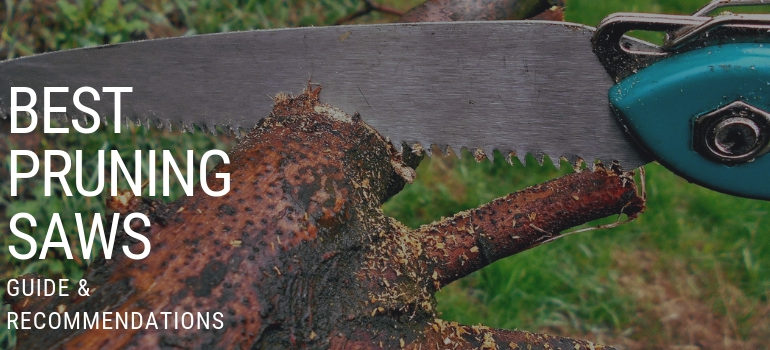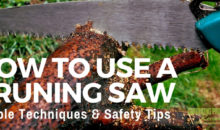Best Pruning Saws: Guide & Recommendations
We independently evaluate all recommended products and services. If you click on links we provide, we may receive compensation.
When faced with pruning tasks where a hand pruner is too small, a lopper is either too big or not big enough and a chainsaw is overkill (and maybe too dangerous), where do you turn? One answer is a pruning saw.
All pruning saws have one thing in common; they all have a metal blade with cutting teeth machined into them.
Beyond that one commonality, they come in all shapes and sizes, from small 6” folding saws that will fit in your pocket to a single blade mounted on a long pole.
They all serve the same purpose – cutting through wood. That can be to remove a part of the plant (tree or shrub) in order to shape it, remove dead or diseased wood, remove the plant entirely (e.g. cutting off a tree at its base), cut up firewood, etc.
In this article, we cover everything you need to know to help you choose the best pruning saw for your needs.
To jump to a specific topic, just click on the any of the Quick Links.
Quick Links
WHAT’S THE RIGHT PRUNING SAW FOR YOU?
There’s a specialty saw for every type of pruning out there. Which one is right for you really depends on the application.
For many people, one general-purpose pruning saw will do the trick. But for some gardeners and DIY landscapers, it’s not enough to have just one type of saw that fits all applications. You might need several different types, particularly if your property has large shrubs and tall trees. For example, if you need to reach a branch that’s fifteen feet over your head you likely won’t use the same type of pruning saw as you would to remove stems from a shrub at ground level or cut up deadwood into smaller pieces.
To see our most highly rated pruning saws, just scroll to the end of this article.
TYPES OF PRUNING SAWS
Folding Hand Saws
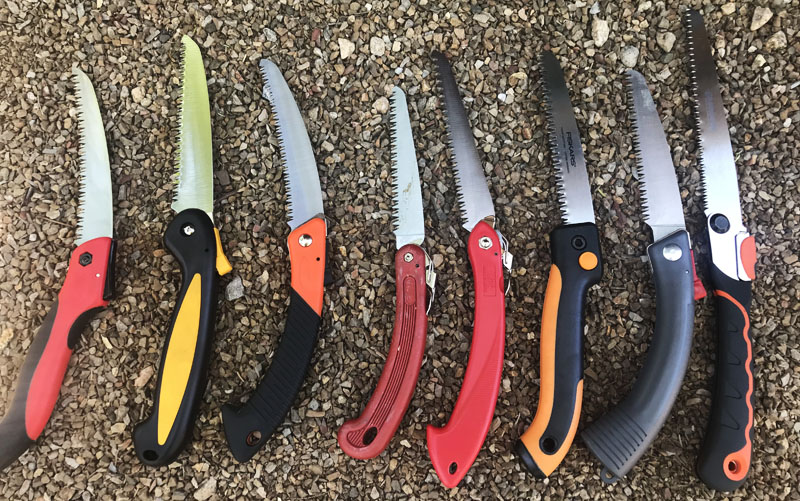
There are a variety of folding saws available from different companies
Folding pruning saws are great when you want portability.
They come in a variety of different sizes to fit nearly any situation. The smallest I’ve seen is less than a foot long with the blade extended and is used for delicate pruning of bonsai trees. The largest one I’ve seen has a blade that borders on twenty inches and an overall length of twice that.
The real question is trying to match the size of the blade length to the largest limb or branch you realistically anticipate pruning. In my experience, the most practical blade length (not including the handle) is somewhere in the six to eight-inch range. I like this size because it fits in my pocket for easy portability but still lets me cut through pretty much anything I need to prune.
We tested several folding saws that fall within this range and you can see the reviews here (reviews coming soon!).
Non-Folding Pruning Saws
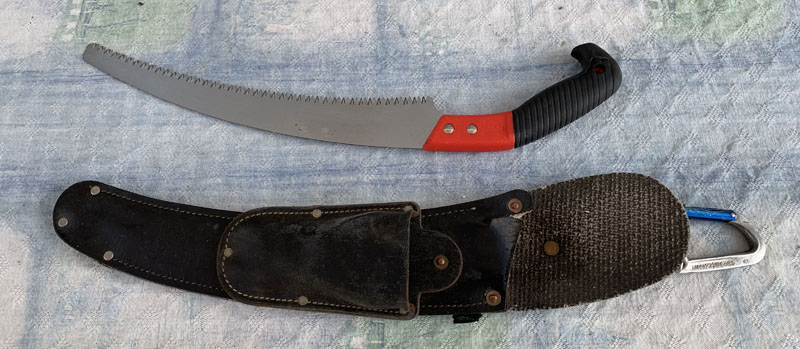
Most non-folding saws will need to be carried in a protective sleeve or carrying case, like this Corona with scabbard
Like folding hand saws, non-folding (straight blade with a handle at one end) saws have their place. They are typically longer than a folding saw, are more rigid (there is no tolerance or “play” between the handle and the blade like you typically find with a folding hand saw) and require some kind of carrying case or scabbard to keep the teeth away from you when not in use.
Non-folding saws come in many shapes and sizes. Choosing one comes down to what you think is the largest diameter branch you will be cutting. This will dictate the blade length (and blade design – curved or straight) and influence the overall length of the saw you decide to purchase.
Pole Saws
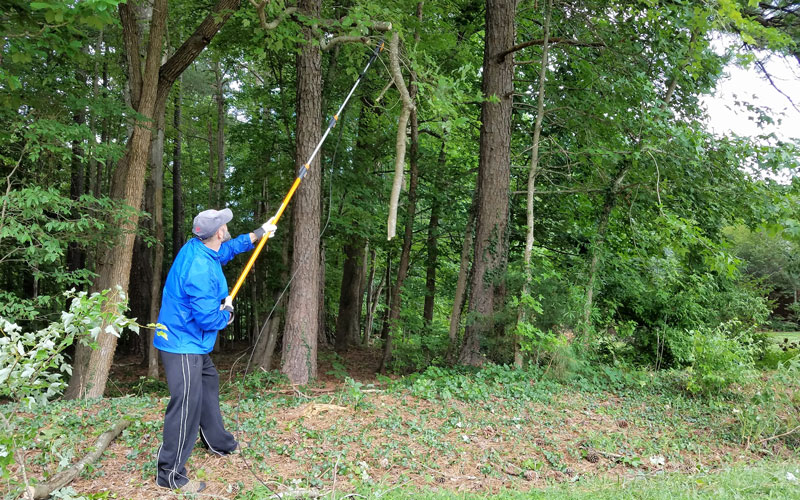
Fiskars Chain Drive Extendable Pole saw in use
A pole saw is basically a blade attached to either a fixed length or telescoping pole (instead of a handle). It is designed to reach high into a tree. These types of saws are best used without a ladder (get a longer pole if necessary) due to the tipping hazards of being on a ladder with a long (and sharp!) implement in your hands.
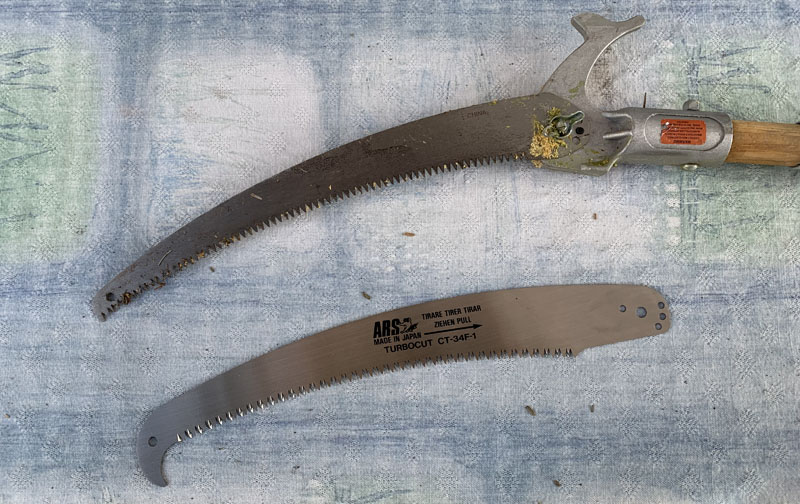
The pole saw blade can be replaced with one that has a hook on the end.
As with folding and non-folding hand saws, blades come in various lengths and designs depending upon the application. Virtually all are curved blades and some even have a hook on the end for pulling cut branches that get stuck in a tree.
Bow Saws
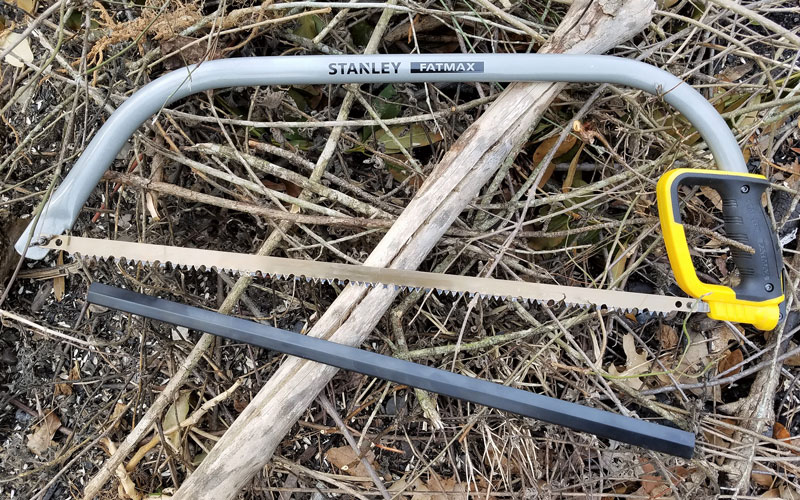
Stanley FATMAX Bow Saw
These are a completely different type of saw than hand or prune saws. They are typically used for “bucking-up” (cutting firewood), cutting larger limbs or cutting down a tree. The blade is stretched (tensioned) between the front and back of the saw. A handle at the back of the saw acts as both the grip and the blade tensioner.
Bow saws can have wooden or metal frames, although most modern bow saws have tubular metal frames with either plastic or metal handles.
BLADE MATERIAL TYPES & HARDENING PROCESS
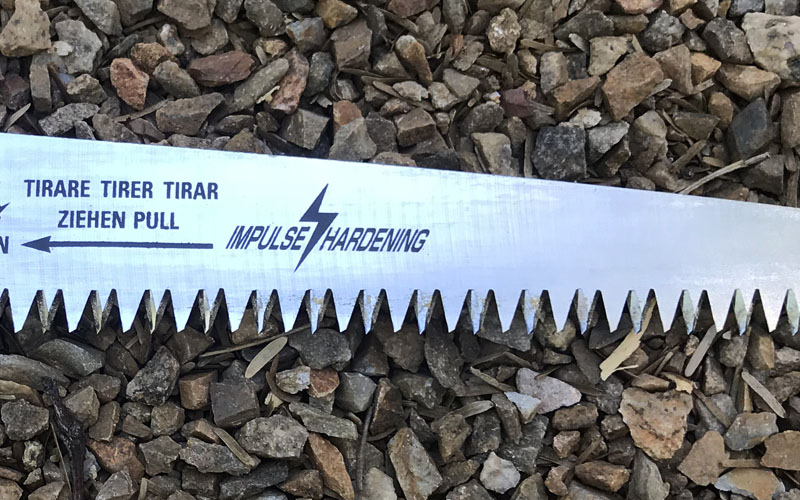
This blade from ARS is impulse hardened, ensuring that it will be long-lasting
Blades these days are usually made from high carbon steel. Think of carbon as the stuff that makes steel hard. The more carbon in the steel, the harder it is. High carbon steel is the preferred material used in folding pruning saw blades because it is so hard and consequently stays sharp for a long time.
This steel is hardened (to keep it sharp longer) using either one of two processes.
- Quench Hardening: This involves a process of heating the saw blade steel to a very high temperature and then dipping it into a bath of oil or water until it cools.
- Impulse Hardening: It’s difficult to describe this so here’s how it’s described by ARS, a premium pruning saw manufacturer: “The process involves both heating and cooling the blade at very precise intervals (within thousandths of a second) using impact energy created by high-frequency currents.” The advantage of impulse hardening is that the teeth are 3x harder than quench hardening and last 3x longer – but you’ll pay a premium for this longevity.
Our tests showed that blades hardened through both technologies cut equally well when the saws are new. But over time the impulse hardened blade will generally win out - not because the teeth are any sharper than quench hardened teeth, but because they stay sharp longer due to the hardening process.
Note that high carbon steel is prone to rust when exposed to moisture, so some sort of coating or plating is a must-have.
Be aware that chrome plating eventually wears off, especially around the teeth. Keep this in mind when caring for your saw as high carbon steel without chrome plating (or a blade coating like the aforementioned Stanley Bow Saw blade) will rust if exposed to moisture.
If your saw blade does start to lose the chrome plating, a light coating of a lubricant along the blade and teeth is the best way to keep your saw free from rust. We recommend Tri-Flow.
CUTTING TEETH GEOMETRY – CUTTING DIRECTION
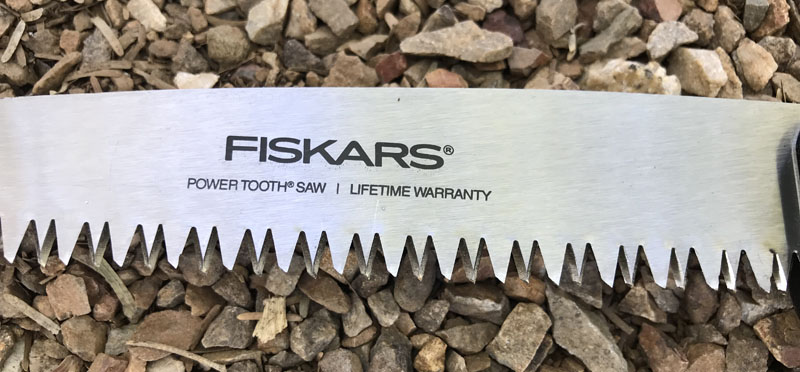
The teeth on the Fiskars Power Tooth Folding Hand Saw
Teeth geometry is critical if you want a fast and clean cut and a non-binding blade. Most saws these days have what is known as a triple ground tooth. This makes them not only extremely sharp but reduces the cutting time by one half, as compared to saws that have a double ground tooth.
Depending upon the geometry of the cutting teeth, the saw will cut on only the pull stroke, only the push stroke, or in both directions. From a human body mechanics standpoint, you can generate more power by pulling than pushing. Keep this in mind when selecting a saw for your different pruning tasks.
STRAIGHT VS CURVED CUTTING BLADES
Pruning saw blades come in two different shapes, straight or curved.

The blade on this ARS folding hand saw is straight
Straight blades are ideally designed for making cuts somewhere between your shoulders and your waist. The natural mechanics of your body make it much easier to use a straight blade in this body position. If you were to use a curved blade at that height, your arm would follow an unnatural up and down motion as the blade rides up one side of the branch and down the other.
It’s also difficult to keep all of the curved saw’s teeth in contact with the branch when using it at torso height; as you pull it toward you or push it away from you, the arched part of the blade will tend to lift off the branch. In contrast, a straight saw will stay in contact with the branch while sawing at a height between your shoulders and your waist.
Conversely, a curved bladed saw is used when sawing over your head or below your waist. The curved blade hooks or digs-in to the wood in this instance, and it’s easier for your body to pull a curved blade than a straight blade when sawing at these angles.

A curved blade, like this one on the Corona Razor Toothed Folding Pruning Saw, works better at lower angles or above your head
So what’s the right answer – should you get a curved or a straight blade if you only have the option of buying one saw?
It really depends where most of your cutting will take place relative to your arm position and your torso.
We strongly recommend that unless you’re a professional arborist (who’s hanging off a rope in the tree, is in a bucket truck, or is on a tied off ladder) you should stay OFF ladders while pruning/cutting. Too many accidents happen each year from having a ladder collapse or fall over while pruning.
If you’re on the ground and need to reach a limb/branch way above your head, then you’ll need a pole saw (either a fixed length pole or one that telescopes). In this situation, you’ll be cutting over your head, hence the need for a curved blade.
If you’re on the ground and reach for a branch over your head, a curved saw will give you a slight power stroke advantage, but a straight blade will work almost as well.
If you only have the budget for a single hand saw (I’m not talking about pole saws here – see above), then I would recommend a straight bladed saw. It gives you more pruning options that are easier on the body if you plan on using it mid-torso or over your head (at ground level) where you can have one hand on the branch being cut and one hand on the saw.
And as an added bonus, straight bladed pruning saws can also be used on DIY house projects like lopping off a 4 x 4 post when you’re building a fence, cutting a 2 x 4 when framing a wall, or slicing a notch in a piece of lumber. You get a “two-for” with a straight bladed saw.
CLEAN CUTS
As far as clean cuts go, you’re not going to know how cleanly it cuts until you try the saw or find an in-depth review. And clean cuts are somewhat subjective; what one considers a clean cut will not necessarily satisfy another.
A “clean” cut is one that doesn’t leave any ragged edges or torn bark when pruning a live tree or shrub. The quality of a cut is usually due to the quality and geometry of the saw’s cutting teeth.
If properly done, a clean cut will “callus” over better than a ragged one. Cleaner cuts are better for the health and vigor of a plant when it is trying to mend the area where the branch/limb was removed.
After testing a lot of pruning saws, it’s apparent that saw manufacturers produce different levels of cutting teeth quality. Most make clean cuts, but some blades and teeth sharpening geometries cut cleaner than others.
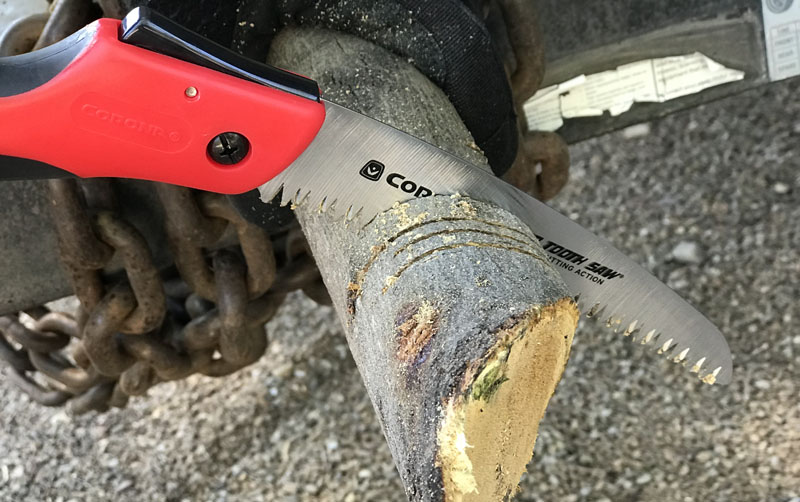
Corona folding hand saw in use
So how do you know which blades cut the cleanest? Educate yourself - read our reviews or those on other blogs, check out YouTube recommendations and see buyer’s verified reviews on e-commerce sites. Just make sure that the saw was actually tested. There are many websites out there that just assemble a list based on Amazon reviews without even picking up the tool…
And as an aside, I’ve found from personal testing of a large number of saws that it isn’t necessarily the most expensive saw that makes the cleanest cut.
BLADE SHARPENING
Can saw teeth be sharpened? The short answer is yes. Specialty files are made for this purpose.
But with the complex cutting teeth angles of today’s specialty pruning saws, I’d steer clear of trying to sharpen a blade yourself. The chances of properly sharpening a blade are slim to none, and one wrong move will ruin the blade.
If you can find a hardware store or arborist supply company, then consider having them sharpen the blade for you. Just consider that if your time is worth any money, then its frequently less expensive to buy a new saw than drive all the way to a saw sharpening place.
And as a final note, impulse hardened blades cannot be sharpened (even by someone who specializes in sharpening saw blade teeth). The steel is just too hard.
REPLACEMENT BLADES
These days, very few manufacturers offer replacement blades for fixed or folding pruning saws. Maybe it’s just the disposable society that we live in.
As an example, I recently reviewed nine folding pruning saws and only three offered replacement blades. In one case, the new saw cost $40.90 plus ($10.08 shipping) and the replacement blade cost $31.35 plus ($10.08 shipping), meaning that a new saw costs just $9.55 more than a new blade. In another case, it clearly made sense to replace the blade as the blade was reasonably priced in comparison to a whole new saw.
Ultimately, it’s about doing your homework before purchasing a saw and deciding if replacement blades are worth it to you or not. I will tell you that if you use your saw a lot, its cutting performance will eventually degrade, especially if you’re cutting a lot of deadwood. Also keep in mind that saw models go out of production, including replacement blades. This may influence your decision.
There is one exception to the above discussion and that is pole saw blades. Replacement blades for these are readily available. There is no need to replace the pole or blade retention head just because you need a new blade. Manufacturers of pole saw blades know this and manufacture replacements for this reason.
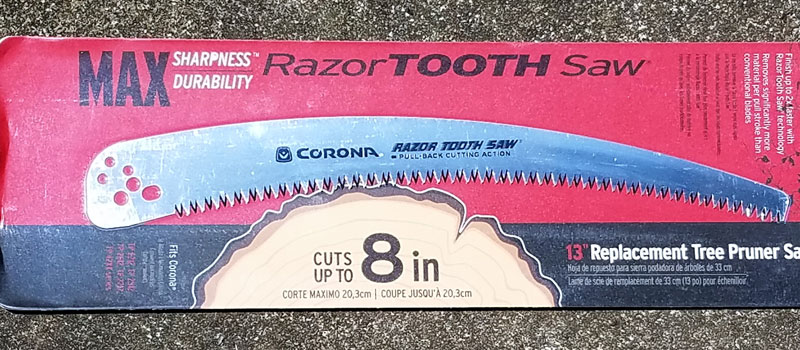
Pole pruner replacement blade
REPLACEMENT PARTS
Like replacement blades, replacement parts (nuts, bolts, screws, pins) are equally hard to find. There are very few companies that supply even a fraction of the parts necessary to rebuild your saw. Each year, fewer and fewer companies offer replacement parts. I guess it’s just easier for them to offer a new saw at nearly the same price as a rebuilt saw instead of providing an inventory of replacement parts.
FOLDING SAW BLADE LOCKING MECHANISMS
Of all the saws I’ve reviewed, I found three different types of blade locking mechanisms. The push button (Fiskars), the thumb lever (Corona, Gardener’s Supply, Centurion, Troy-Bilt, A.M. Leonard) and the swing lock (ARS).

Folding saw blade locking mechanisms. From top to bottom: the Fiskars button, Corona thumb lever, and ARS swing lock
My favorite is the swing lock by ARS. I found it the most secure of all the saws. But depending upon which saw you buy, you’re stuck with that manufacturer’s design. Don’t get me wrong, they all do the job, I just prefer one over the others.
Some of the saws lock the blade in both the open and closed position (Corona, Centurion, Fiskars, Troy-Bilt, A.M. Leonard). The rest (ARS, Gardener’s Supply) only lock the blade in the open position.
From a safety standpoint, the blade locking in both directions has some merit, but I did not find that the saws that locked in the open only configuration were any less safe. In my reviews, none of those saws unintentionally opened from the closed position, even without a lock to keep it close. That’s not to say it’s impossible, but I didn’t find it to be a problem.
If you’re concerned, then go with the folding pruning saw that locks in both directions.
HANDLES & GRIPS FOR HAND SAWS
Most hand saws offer a variety of grip styles.
Some, like the bow saw, usually have you gripping the wood frame or metal tube and blade-tensioning arm at the same time. Some of the more modern bow saws, such as the Stanley FATMAX below, have an additional handle on the side.

Stanley FATMAX bow saw handle
Non-folding and most folding hand saws are designed to be used with one hand and have a “hook” at the end of the handle to prevent your hand from slipping off the saw while in use.
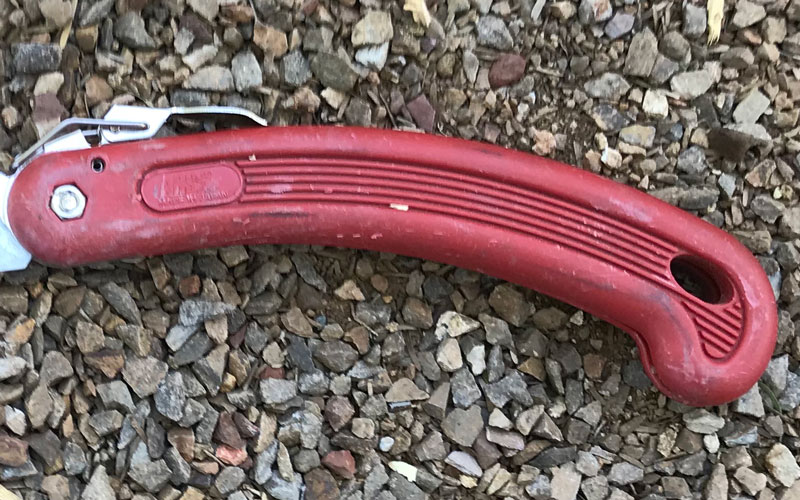
The ARS Pocket Saw handle is curved for a better grip and to prevent slipping
Some saws still offer wooden grips (with a similar shape to the more commonly found composite based handles) and others have wooden grips like that seen on a carpenter’s saw.
With a pole saw, you’ll be holding onto either a fiberglass tube or round wooden shaft.
Non-slip grips help prevent your hand from slipping and give you better control over the saw. These grips come in a variety of materials, including a rubber-like compound, silicon-based material, grooves that are molded into plastic/composite handles, or just plain plastic-like contoured grips.

Being able to grip the handle of the saw with gloves on is important
The key is to find a grip that’s comfortable for you to hold. To do that, you’ll have to try out a few saws and/or read detailed reviews from people who’ve put the saw through its paces.
SAFETY CONSIDERATIONS
There are two must-haves while using any type of pruning saw (where you’re not sawing above your head. These are a pair of good sturdy gloves (preferably leather) and a pair of good-quality safety glasses (such as these from Wiley-X ).
Today’s teeth sharpening techniques make the blades extremely sharp. One slip without a pair of gloves can ruin your day.
Safety glasses prevent sawdust from falling in your eyes while cutting over your head/windy day, snapped branches from striking you in the eye, or a saw blade breaking and having a metal fragment launched into your eye.
Also, if you plan on pruning over your head where you can’t hold onto the branch with one hand while cutting it, then a hard hat is necessary. A falling branch from a pole saw cut way above your head without using a hard hat is a prescription for disaster.
WHERE DO WE GO FROM HERE?
Well, there are a few questions you might consider before purchasing a pruning saw:
- What’s your budget?
- How many times per week, month, year are you going to use it?
- Are there certain features that you like or must have?
- Does the brand play a big role in your purchase decision?
- Are there any features that you like or dislike?
- What’s the optimal blade length that will get 80% of the job done with 20% of the effort?
- Do you want a tool for life or will you buy a new one when the old one fails?
- Do aesthetics play into your decision?
- Do you place a lot of faith in reviews to help you make your buying decision?
- Do you have to touch and feel it in the (bricks and mortar) store before you buy it?
- Do you need more than one saw (since your property requires specialty saws for different pruning jobs)?
- Is the saw going to be used primarily to cut up deadwood into firewood or more manageable pieces?
IN SUMMARY
Finding the right saw for the right job may seem a little overwhelming, hence the questions above to help guide your decision-making process.
Personally, I believe in the adage that “you get what you pay for”. A really inexpensive, cheaply manufactured saw will not perform in the manner required. On the other hand, a quality tool that makes clean, precision cuts will not only make the job easier and more enjoyable, it will also benefit the tree/shrub through faster healing and a more vigorous plant (assuming the pruning cuts have been made properly).
There are a lot of manufacturers out there that make quality pruning saws. Now it’s time for you to make a decision and go out and have some fun.
HIGHLY RECOMMENDED FOLDING PRUNING SAWS
We'll be publishing individual reviews of different pruning saws soon, but in the meantime, here were our top-rated ones, available for purchase in various hardware stores, and online at Amazon.com.
The ARS G-18HL (with impulse-hardened teeth) is available at Wood Avenue.
Highly Recommended Pole Saws
No products found.
Last update on 2024-04-19 / Affiliate links / Images from Amazon Product Advertising API
Enjoyed This Review?
If you liked this review, please sign up for our email updates with reviews, how-to articles and gardening videos!

